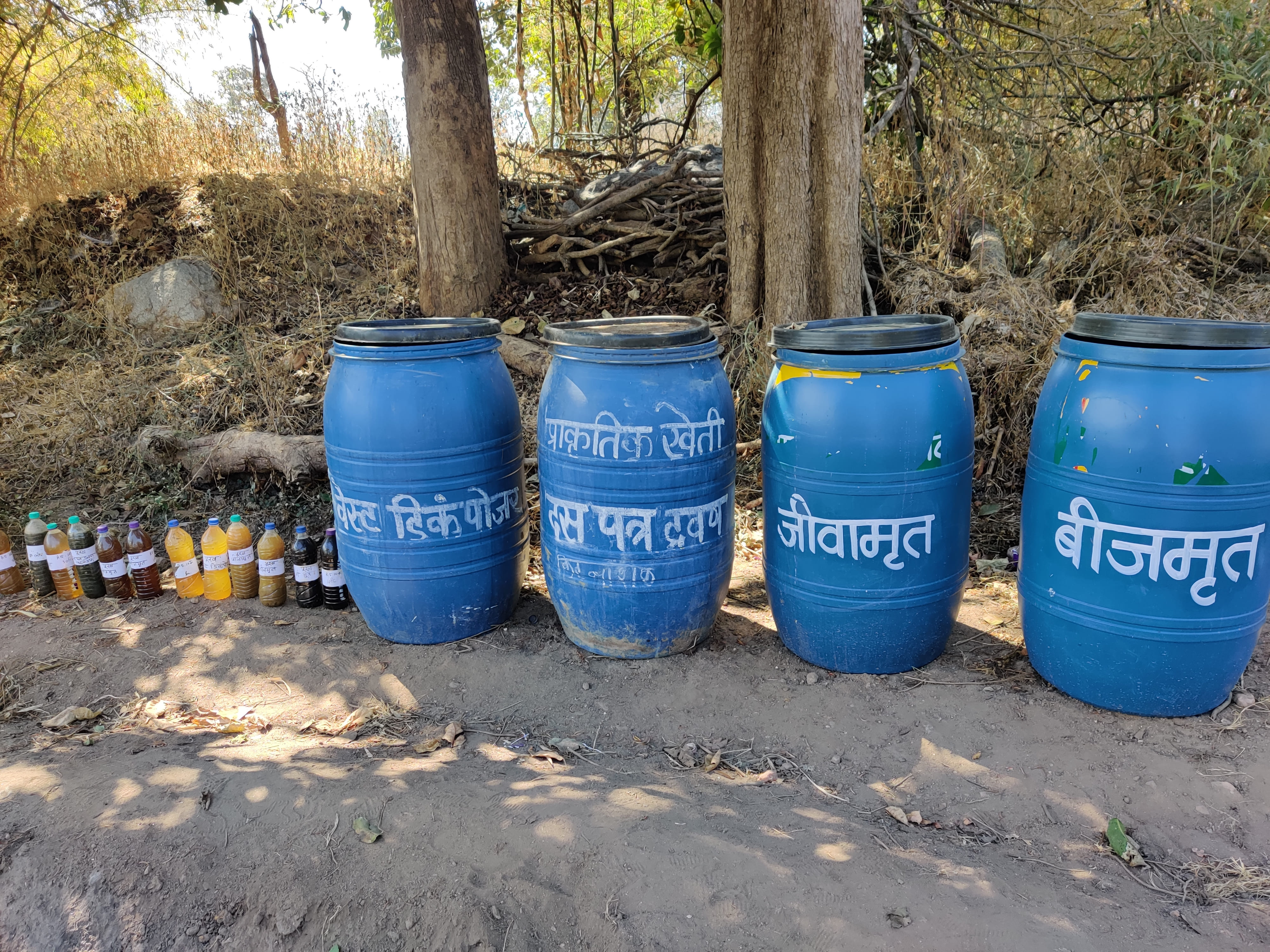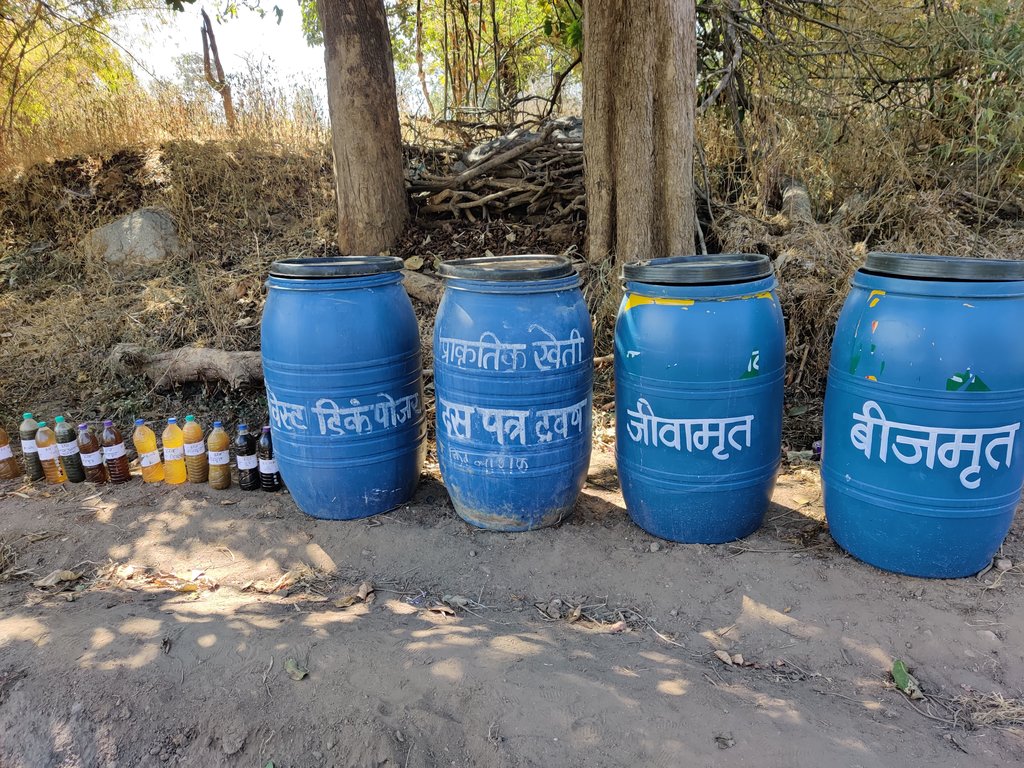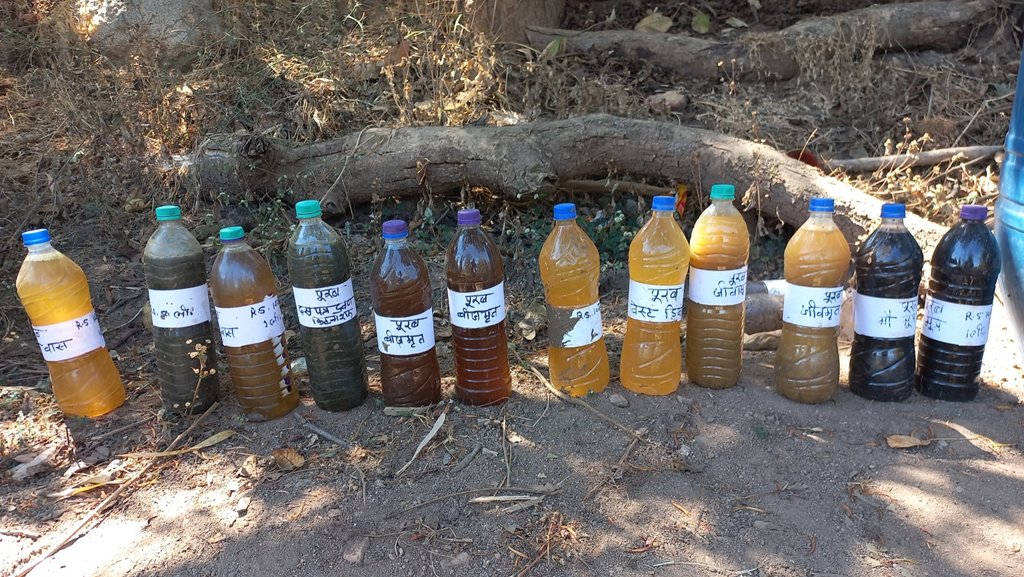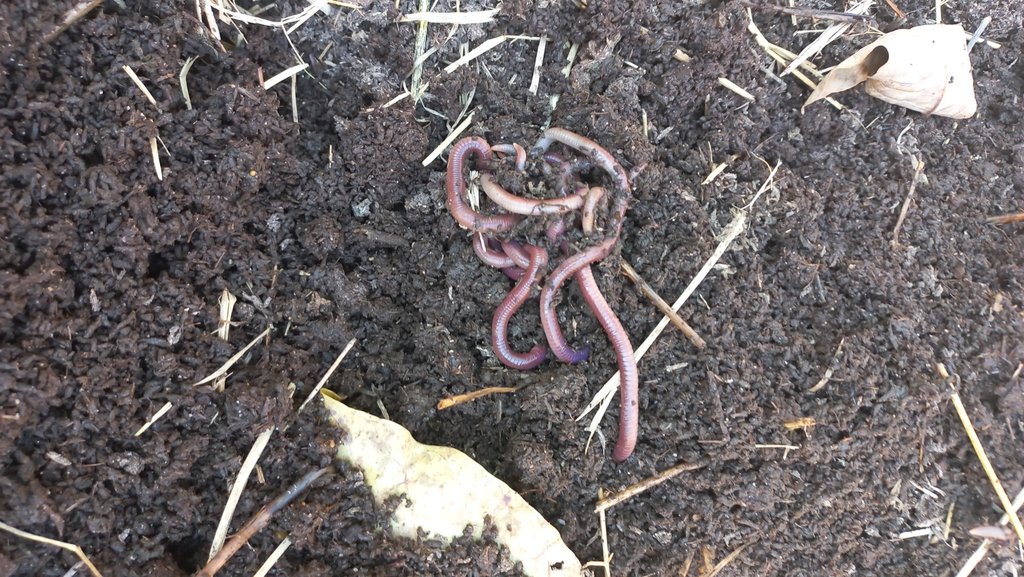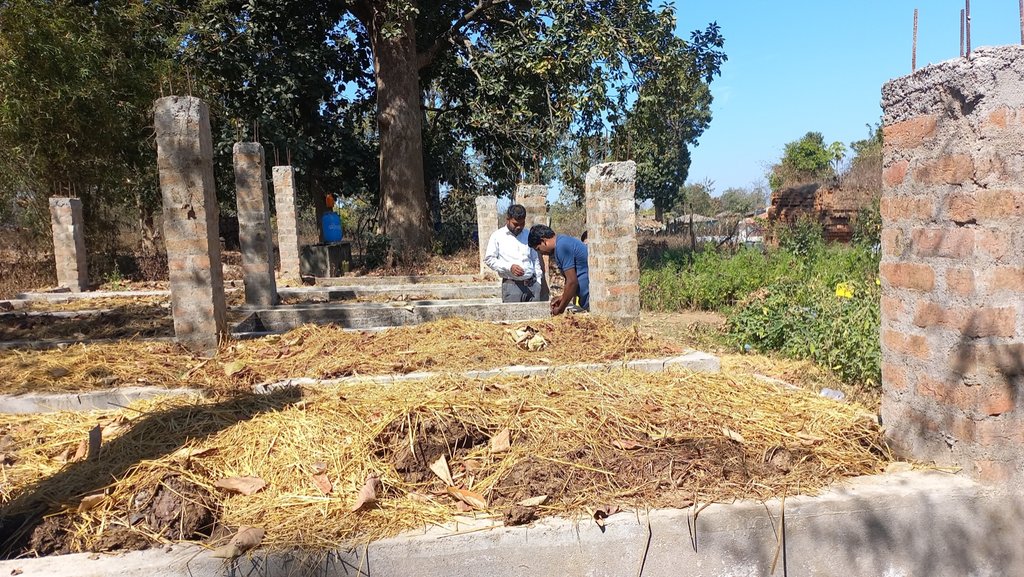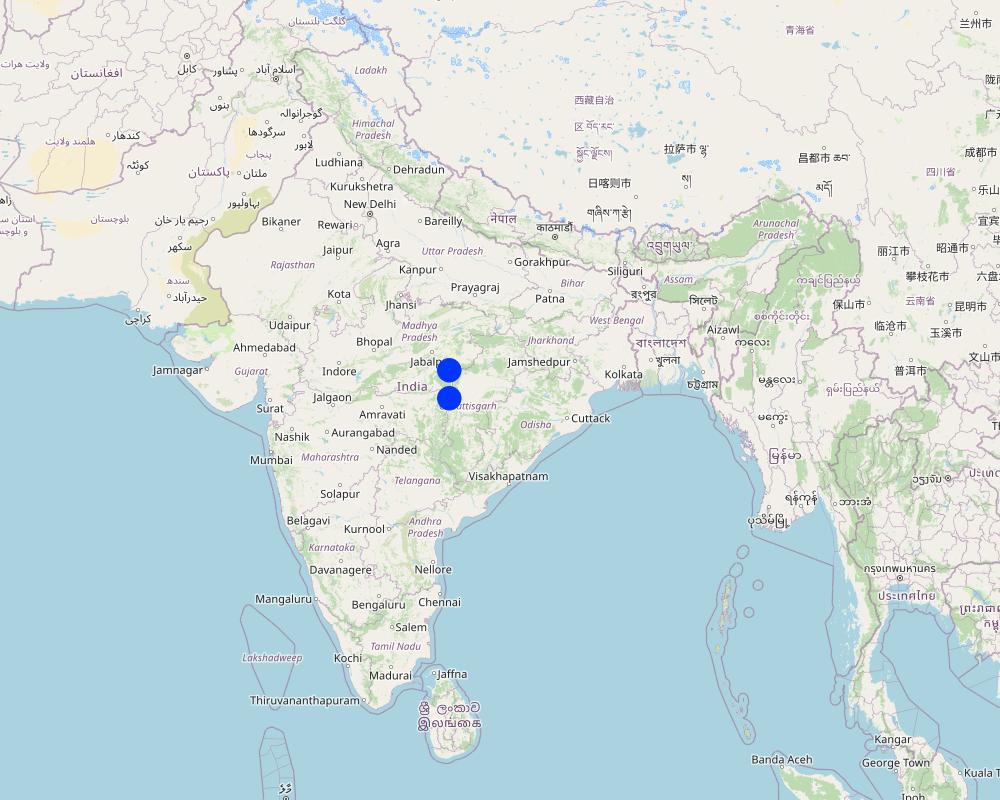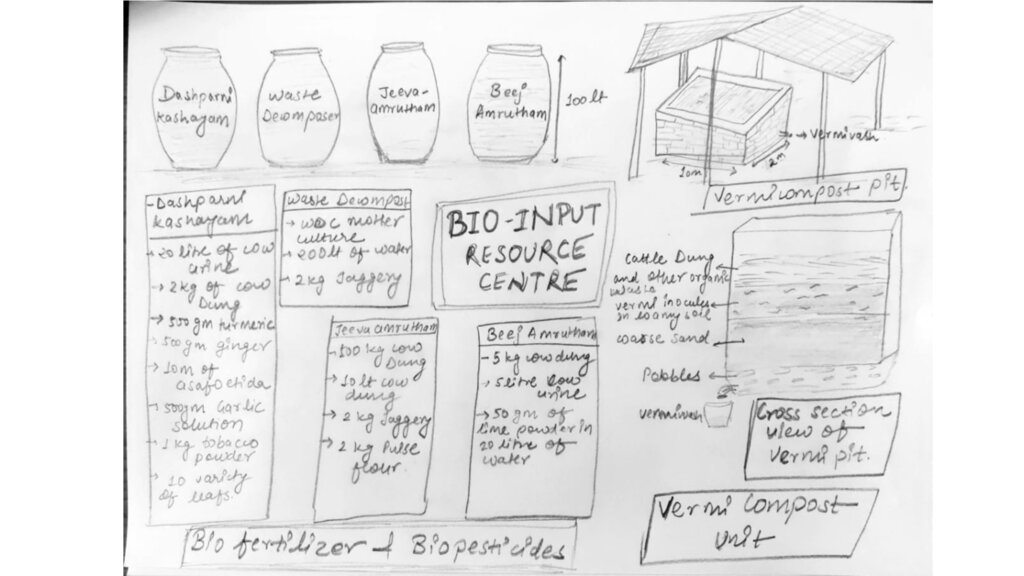Preparation of Bio-Inputs such as Vermicompost, Biofertilizers, and Biopesticides [India]
- Creation:
- Update:
- Compiler: Santosh Gupta
- Editors: Noel Templer, Stephanie Katsir, Kim Arora, Tabitha Nekesa, Ahmadou Gaye, Siagbé Golli
- Reviewers: Udo Höggel, Joana Eichenberger, Sally Bunning
Kechua khaad, Beej Amrutham, Jeevamrutham, Dashparni and compost
technologies_6695 - India
- Full summary as PDF
- Full summary as PDF for print
- Full summary in the browser
- Full summary (unformatted)
- Preparation of Bio-Inputs such as Vermicompost, Biofertilizers, and Biopesticides: June 25, 2023 (inactive)
- Preparation of Bio-Inputs such as Vermicompost, Biofertilizers, and Biopesticides: Sept. 14, 2023 (inactive)
- Preparation of Bio-Inputs such as Vermicompost, Biofertilizers, and Biopesticides: April 17, 2024 (public)
View sections
Expand all Collapse all1. General information
1.2 Contact details of resource persons and institutions involved in the assessment and documentation of the Technology
Name of project which facilitated the documentation/ evaluation of the Technology (if relevant)
Soil protection and rehabilitation for food security (ProSo(i)l)Name of the institution(s) which facilitated the documentation/ evaluation of the Technology (if relevant)
Deutsche Gesellschaft für Internationale Zusammenarbeit (GIZ) - GermanyName of the institution(s) which facilitated the documentation/ evaluation of the Technology (if relevant)
CIAT International Center for Tropical Agriculture (CIAT International Center for Tropical Agriculture) - KenyaName of the institution(s) which facilitated the documentation/ evaluation of the Technology (if relevant)
Ecociate Consultants (Ecociate Consultants) - India1.3 Conditions regarding the use of data documented through WOCAT
The compiler and key resource person(s) accept the conditions regarding the use of data documented through WOCAT:
Yes
1.4 Declaration on sustainability of the described Technology
Is the Technology described here problematic with regard to land degradation, so that it cannot be declared a sustainable land management technology?
No
2. Description of the SLM Technology
2.1 Short description of the Technology
Definition of the Technology:
Bioresource Center (BRC) is an enterprise model to promote the preparation and commercialization of bio-inputs to help farmers adopt natural and sustainable agriculture practices. The bio-inputs and composting material under such models are prepared using locally available material at very affordable prices.
2.2 Detailed description of the Technology
Description:
Bioresource Center (BRC) is a community-led enterprise to produce bio-inputs and compost from locally available bioresources for improving soil health and fertility, managing pest and disease, and meeting the nutrient requirement for the crops. BRCs have been envisaged as a potential enterprise solution to meet the requirements of small and marginal farmers who do not have time and resources to make their own bio-inputs and composting material. Such farmers can purchase the bio-inputs at very affordable prices from the BRCs being operated by either individual entrepreneurs or community-based institutions of male and female farmers.
Essentially it is an enterprise-led platform that can create the necessary conditions to scale the adoption of better farming practices. The technology for bioresource units is applied in both natural and human environments to promote sustainable agriculture and improve livelihoods in rural communities. The establishment and maintenance of a bioresource unit require inputs such as organic waste materials, earthworms, inoculants, and water, as well as activities such as vermicomposting, biofertilizer and biopesticide production, training and capacity building, and monitoring and evaluation.
The technological inputs produced include various type of tried and tested local formulations like microbial preparations such as Jeevamrut (Soil life elixir), Ghana Jeevamrith(compact and aggregated form of Soil Life Elixir), Beejamrut (Microbial Seed Dressing), Waste Decomposer, etc.; botanical decoctions like Panchagavya ( 5 cow based products formulation - Milk, Curd, cow-urine, cow-dung, ghee), Dashparni (Extract of 10 leaves available locally), Neemastra (Extarct of Neem leaves and seeds (Azadirachta indica), Brahmastra (Referes to the highly effective pest controlling material made out of chilli, garlic and other local materials), agniastra (Refers to the fire powering material for controlling pest), NSKE (Neem seed kernel extract) ; and biopesticides cultures like Beauveria, Verticillium, Trichoderma, Pseudo-monas, NPV formulations/cultures. Beyond this, the platform enables the supply of seeds of green manuring crops, vermiculture/compost, Neem / karanj cake, Cow dung/cow urine, briquets, seeds/seedlings of trap crops, etc. For a detailed list of different sub-technologies - preparations, their ingredients and processing one can refer to BIO-INPUT RESOURCE CENTER MANUAL FROM NATIONAL COALITION FOR NATURAL FARMING at: (https://indiaclimatecollaborative.org/wp-content/uploads/2022/09/BRC-Technical-manual.pdf)
This technology does not require much investment and material. 2-3 plastic containers of 200 litres and 2-3 containers of 100 litres or any other locally available utensil are good enough to make these bio-inputs. The preparation method for each of the inputs is a bit different from each other, while some of the inputs are being prepared by extracting the paste from leaves or other materials like chilli, garlic etc, others are prepared by mixing them with cow dung and cow urine. Cow urine is one of the most important substances for preparing these inputs. The urine of indigenous cows are considered more effective for preparing these inputs. The document shared above can be refereed to for the preparation method of each of the bio-inputs.
The bioresource unit technology has numerous benefits and impacts, including improved soil health, reduced dependence on synthetic inputs, increased crop yields, reduced environmental impact, enhanced biodiversity, reduced greenhouse gas emissions, and improved human health. Land users generally appreciate the benefits of the bioresource unit technology, particularly its cost-effectiveness, improved soil health, and reduced environmental impact. However, there are also challenges related to the labor-intensiveness of the technology, the need for technical knowledge, and the dependence on local resources.
By using natural inputs and locally available resources, this technology can help to create a more sustainable and equitable food system for people and for land also. These functions contribute to a healthier environment, healthier crops, and healthier communities.
2.3 Photos of the Technology
General remarks regarding photos:
All the photos have been taken with consents of participants
2.4 Videos of the Technology
Comments, short description:
Video of the technology
https://www.youtube.com/watch?v=hW2xEpWyIa8
Hindi narration of the bioinput resource center during the field visit.
Date:
19/03/2023
Location:
Mandla, Madhya Pradesh, India
Name of videographer:
Santosh Gupta
2.5 Country/ region/ locations where the Technology has been applied and which are covered by this assessment
Country:
India
Region/ State/ Province:
Madhya Pradesh
Further specification of location:
Bichhiya Block, Mandla District, Madhya Pradesh
Specify the spread of the Technology:
- applied at specific points/ concentrated on a small area
Is/are the technology site(s) located in a permanently protected area?
No
Comments:
The technology was implemented in some of the selected villages of the Bichhiya Block in the Mandla District of Madhya Pradesh. These villages are located in and around a tiger reserve park.
Map
×2.6 Date of implementation
Indicate year of implementation:
2018
2.7 Introduction of the Technology
Specify how the Technology was introduced:
- through land users' innovation
- during experiments/ research
- through projects/ external interventions
3. Classification of the SLM Technology
3.1 Main purpose(s) of the Technology
- improve production
- reduce, prevent, restore land degradation
- conserve ecosystem
- preserve/ improve biodiversity
- adapt to climate change/ extremes and its impacts
- create beneficial economic impact
- Control pest and diseases
3.2 Current land use type(s) where the Technology is applied
Land use mixed within the same land unit:
No

Cropland
- Annual cropping
Annual cropping - Specify crops:
- oilseed crops - sunflower, rapeseed, other
- cereals - wheat (winter)
- cereals - maize
- cereals - rice (wetland)
- legumes and pulses - lentils
- vegetables - leafy vegetables (salads, cabbage, spinach, other)
Number of growing seasons per year:
- 2
Specify:
During the monsoon, farmers are cultivating the rice while during the winter season they are growing wheat, chick-pea, mustard and other crops
Is intercropping practiced?
Yes
If yes, specify which crops are intercropped:
Chick pea intercropped with beans, mixed cropping system of vegetables
Is crop rotation practiced?
Yes
If yes, specify:
Rice-Chick pea, Rice-Wheat
Comments:
The technology has enabled farmers to get easy access to bio-inputs, which has led to the adoption of natural and sustainable farming practices in the field. This has also promoted mixed farming systems among the farmers as natural farming is more suited to such cropping systems.
3.3 Has land use changed due to the implementation of the Technology?
Has land use changed due to the implementation of the Technology?
- No (Continue with question 3.4)
Comments:
The land use pattern remained same. Farmers are cultivating the crops both before and after the intervention.
3.4 Water supply
Water supply for the land on which the Technology is applied:
- mixed rainfed-irrigated
Comments:
Most farmers cultivate under rainfed conditions due to the unavailability of any external irrigation facility. There are a few farmers who apply irrigation.
3.5 SLM group to which the Technology belongs
- integrated crop-livestock management
- integrated soil fertility management
- integrated pest and disease management (incl. organic agriculture)
3.6 SLM measures comprising the Technology

agronomic measures
- A2: Organic matter/ soil fertility
- A4: Subsurface treatment
- A6: Residue management
A6: Specify residue management:
A 6.4: retained

other measures
Specify:
Pest and diseases management measures to reduce the use of chemical fertilizers and pesticides
Comments:
Bio-inputs are an effective alternative to reduce or replace the use of synthetic fertilisers and pesticides. The use of these inputs ensure lesser pollution of air and water, safe food and improved biodiversity.
3.7 Main types of land degradation addressed by the Technology

chemical soil deterioration
- Cn: fertility decline and reduced organic matter content (not caused by erosion)
- Cp: soil pollution

biological degradation
- Bp: increase of pests/ diseases, loss of predators

water degradation
- Hp: decline of surface water quality
Comments:
Control over pest and disease along with improved soil microbial activity as an outcome of vermicompost application has ensured better soil health and improved production.
3.8 Prevention, reduction, or restoration of land degradation
Specify the goal of the Technology with regard to land degradation:
- reduce land degradation
4. Technical specifications, implementation activities, inputs, and costs
4.1 Technical drawing of the Technology
Technical specifications (related to technical drawing):
The drawing indicates the overall flow and design of the bioresource unit as seen in one of the enterprises in the project area. It consists of vermicompost pits of 6ft in length, 4 ft in depth, and 2 ft in width. The enterprise has 10 such pits. The drawing also covers the placement and structure of other equipment such as vermiwash and bio-inoculate units.
Author:
Payal
Date:
08/03/2023
4.2 General information regarding the calculation of inputs and costs
Specify how costs and inputs were calculated:
- per Technology unit
Specify unit:
Vermicompost unit is a pit, biofertilizer and pesticides unit in litre, Materials is in Kg
If relevant, indicate exchange rate from USD to local currency (e.g. 1 USD = 79.9 Brazilian Real): 1 USD =:
82.0
Indicate average wage cost of hired labour per day:
3
4.3 Establishment activities
| Activity | Timing (season) | |
|---|---|---|
| 1. | Digging for vermicompost pits | October |
| 2. | Construction of vermicompost pit | October |
| 3. | Construction of Cattle Management Shed | March |
4.4 Costs and inputs needed for establishment
| Specify input | Unit | Quantity | Costs per Unit | Total costs per input | % of costs borne by land users | |
|---|---|---|---|---|---|---|
| Labour | Digging for vermicompost pit | piece | 2.0 | 1000.0 | 2000.0 | 100.0 |
| Labour | Construction of vermicompost pit | piece | 2.0 | 4000.0 | 8000.0 | 100.0 |
| Equipment | Drum 500 lts | piece | 5.0 | 600.0 | 3000.0 | 100.0 |
| Plant material | Pulse flour | Kg | 3.0 | 70.0 | 210.0 | 100.0 |
| Plant material | Jageery | Kg | 3.0 | 60.0 | 180.0 | 100.0 |
| Plant material | Turmeric | Kg | 0.5 | 100.0 | 50.0 | 100.0 |
| Plant material | Ginger paste | Kg | 0.5 | 120.0 | 60.0 | 100.0 |
| Plant material | Asafoetida | Gramm | 10.0 | 3.0 | 30.0 | 100.0 |
| Plant material | Chillies | Kg | 1.0 | 100.0 | 100.0 | 100.0 |
| Plant material | Garlic | Kg | 0.5 | 160.0 | 80.0 | 100.0 |
| Plant material | Tobbaco | Kg | 0.5 | 200.0 | 100.0 | 100.0 |
| Fertilizers and biocides | Cow dung | Kg | 120.0 | 2.0 | 240.0 | 100.0 |
| Fertilizers and biocides | Cow urine | Litre | 25.0 | 5.0 | 125.0 | 100.0 |
| Fertilizers and biocides | Lime | Gramm | 50.0 | 0.25 | 12.5 | 100.0 |
| Fertilizers and biocides | Farm Yard Manure for Vermicompost | Kg | 1000.0 | 10.0 | 10000.0 | 100.0 |
| Construction material | Brick | Piece | 100.0 | 10.0 | 1000.0 | 100.0 |
| Construction material | Cement | Sack | 3.0 | 300.0 | 900.0 | 100.0 |
| Construction material | Stone | Sack | 2.0 | 500.0 | 1000.0 | 100.0 |
| Other | Vermi inocules | Kg | 40.0 | 450.0 | 18000.0 | 100.0 |
| Total costs for establishment of the Technology | 45087.5 | |||||
| Total costs for establishment of the Technology in USD | 549.85 | |||||
4.5 Maintenance/ recurrent activities
| Activity | Timing/ frequency | |
|---|---|---|
| 1. | Preparations | Every season |
| 2. | Packaging and Selling | Everyseason |
| 3. | Capacity building | Every season |
| 4. | Application at field | Kharif and Rabi Seaon |
| 5. | Harvesting of vermicompost | In every 3 months |
| 6. | Filling of pit | In every 3 months after Harvesting |
4.6 Costs and inputs needed for maintenance/ recurrent activities (per year)
| Specify input | Unit | Quantity | Costs per Unit | Total costs per input | % of costs borne by land users | |
|---|---|---|---|---|---|---|
| Labour | Preparation of bio-inputs | Person days | 50.0 | 200.0 | 10000.0 | 100.0 |
| Labour | Packaging, marketing | Person days | 10.0 | 250.0 | 2500.0 | 100.0 |
| Fertilizers and biocides | Cow dung or FYM for filling pit | Kg | 100.0 | 10.0 | 1000.0 | 100.0 |
| Fertilizers and biocides | Different material to prepare bio-inputs | kg | 200.0 | 15.0 | 3000.0 | 100.0 |
| Other | Packaging and Selling | Sack | 100.0 | 5.0 | 500.0 | 100.0 |
| Total costs for maintenance of the Technology | 17000.0 | |||||
| Total costs for maintenance of the Technology in USD | 207.32 | |||||
Comments:
After harvesting of vermicompost, maintenance of the pit is required by refilling pit with farm yard manure (FYM). For selling biofertilizers and biopesticides new batch preparation incl. all input materials is required.
4.7 Most important factors affecting the costs
Describe the most determinate factors affecting the costs:
The availability of locally available raw materials and labor
5. Natural and human environment
5.1 Climate
Annual rainfall
- < 250 mm
- 251-500 mm
- 501-750 mm
- 751-1,000 mm
- 1,001-1,500 mm
- 1,501-2,000 mm
- 2,001-3,000 mm
- 3,001-4,000 mm
- > 4,000 mm
Specify average annual rainfall (if known), in mm:
1427.00
Specifications/ comments on rainfall:
The highest rainfall period is from June to September during the monsoon season.
Indicate the name of the reference meteorological station considered:
Mandla, Madhya Pradesh
Agro-climatic zone
- semi-arid
The climate of the district is tropical, with moderate winters, severe summers, and well-distributed rainfall received from the southwest monsoon. However, due to higher general elevation and abundance of forests, summer temperatures do not rise as much as in other areas.
5.2 Topography
Slopes on average:
- flat (0-2%)
- gentle (3-5%)
- moderate (6-10%)
- rolling (11-15%)
- hilly (16-30%)
- steep (31-60%)
- very steep (>60%)
Landforms:
- plateau/plains
- ridges
- mountain slopes
- hill slopes
- footslopes
- valley floors
Altitudinal zone:
- 0-100 m a.s.l.
- 101-500 m a.s.l.
- 501-1,000 m a.s.l.
- 1,001-1,500 m a.s.l.
- 1,501-2,000 m a.s.l.
- 2,001-2,500 m a.s.l.
- 2,501-3,000 m a.s.l.
- 3,001-4,000 m a.s.l.
- > 4,000 m a.s.l.
Indicate if the Technology is specifically applied in:
- not relevant
Comments and further specifications on topography:
The topography of the project area consists of a hilly area and a forest area. Mandla district is hilly and forested (Satpura hill range) and highly undulating with a narrow strip of cultivated plains in the valley portion of the river. The plateau is in the northern part formed by basalt, and east-west trending hills in the southern part. The highest elevation is 934 m amsl in the northern part, and the lowest is around 400 m amsl in the northwestern part of the area. The elevation of the studied block Bichhiya is 453 m amsl.
Source: District at a glance; Ministry of water resources, Government of Madhya Pradesh
5.3 Soils
Soil depth on average:
- very shallow (0-20 cm)
- shallow (21-50 cm)
- moderately deep (51-80 cm)
- deep (81-120 cm)
- very deep (> 120 cm)
Soil texture (topsoil):
- coarse/ light (sandy)
- medium (loamy, silty)
Soil texture (> 20 cm below surface):
- medium (loamy, silty)
Topsoil organic matter:
- low (<1%)
If available, attach full soil description or specify the available information, e.g. soil type, soil PH/ acidity, Cation Exchange Capacity, nitrogen, salinity etc.
Soil Testing Parameter status (Average) 2017-20 for the project areas is as follows. This data is based on the soil samples tested by the FES in its soil labs from the project villages:
Soil pH:- 5.906548628; EC (electrical conductivity):- 0.122993577; Soil Organic Carbon:- 0.83%; Nitrogen:- 293.3696598; Phosphorus:- 25.77762582; Potassium (K):- 139.6696636; Sulphur (S):-18.93457993; Zinc (Zn):- 0.955246706; Boron (Bn):- 0.490850376
5.4 Water availability and quality
Ground water table:
> 50 m
Availability of surface water:
medium
Water quality (untreated):
poor drinking water (treatment required)
Water quality refers to:
both ground and surface water
Is water salinity a problem?
No
Is flooding of the area occurring?
No
Comments and further specifications on water quality and quantity:
The groundwater status is within the safe limits as per the reports by the Government of Madhya Pradesh. People use water from rivers, streams, and traditional small wells for domestic purposes. In the absence of good vegetative cover, the rainwater washes off the fertile topsoil from the farmlands making the land barren and resulting in the siltation of ponds and other water bodies. Further, a heavy infestation of invasive species such as Lantana Camara compounds the degradation.
The studied block Bichhiya is in a better position in terms of stage of groundwater Development with 17%, while the district average is 7%.
Source: http://cgwb.gov.in/District_Profile/MP/Mandla.pdf
5.5 Biodiversity
Species diversity:
- high
Habitat diversity:
- high
Comments and further specifications on biodiversity:
The bio-input resource unit or center is present nearby the forest area of Kanha National Park. The high biodiversity present in the technology implementation area. Ecological assessment report in Mandla (where this Technology is applied) showed improved biodiversity on common lands under village governance compared to open-access or commons under government ownership. On average, the Shannon diversity index of managed common lands was 1.45 compared to 0.42 for the open access or ungoverned commons. Most of the sites under open access lands are infested by Lantana camara, which is the main reason for the lower biomass and diversity of the ungoverned lands.
5.6 Characteristics of land users applying the Technology
Sedentary or nomadic:
- Sedentary
Market orientation of production system:
- mixed (subsistence/ commercial)
Off-farm income:
- > 50% of all income
Relative level of wealth:
- poor
Individuals or groups:
- groups/ community
Level of mechanization:
- manual work
- animal traction
Gender:
- women
- men
Age of land users:
- youth
- middle-aged
5.7 Average area of land used by land users applying the Technology
- < 0.5 ha
- 0.5-1 ha
- 1-2 ha
- 2-5 ha
- 5-15 ha
- 15-50 ha
- 50-100 ha
- 100-500 ha
- 500-1,000 ha
- 1,000-10,000 ha
- > 10,000 ha
Is this considered small-, medium- or large-scale (referring to local context)?
- small-scale
Comments:
The bio-inputs are being prepared by more than 100 users and applied by 1000 farmers in their fields as part of the intervention. There are around 20 enterprise units in the project area, which are preparing the bio-inputs and selling them to other farmers.
5.8 Land ownership, land use rights, and water use rights
Land ownership:
- individual, titled
Land use rights:
- individual
Water use rights:
- communal (organized)
- individual
Are land use rights based on a traditional legal system?
Yes
Specify:
Some of the land parcels are ancestral land units while some have been transferred by the State Government over the years.
5.9 Access to services and infrastructure
health:
- poor
- moderate
- good
education:
- poor
- moderate
- good
technical assistance:
- poor
- moderate
- good
employment (e.g. off-farm):
- poor
- moderate
- good
markets:
- poor
- moderate
- good
energy:
- poor
- moderate
- good
roads and transport:
- poor
- moderate
- good
drinking water and sanitation:
- poor
- moderate
- good
financial services:
- poor
- moderate
- good
6. Impacts and concluding statements
6.1 On-site impacts the Technology has shown
Socio-economic impacts
Production
crop production
Comments/ specify:
The use of compost, bio-fertilisers and other nutrient-rich material has improved farm productivity to a great extent
crop quality
Comments/ specify:
Improvement in crop quality such as size of the grains and vegetables, nutrient content, their aroma has improved due to application of inputs made at BRC
risk of production failure
Comments/ specify:
The local material including the local seeds are more resilient to the extreme climatic events and offer a reduced risk to the farmers
product diversity
Income and costs
expenses on agricultural inputs
Comments/ specify:
Use of local materials, low-tech home-based processing, and open source availability of technology enables farmers to produce their organic inputs at home essentially only costing capital such as plastic container and labour, thus improving the accessibility of good farming inputs to even disadvantaged groups such as small farmers, marginalised communities, landless farmers, ultra-poor, etc.
farm income
Comments/ specify:
Farmers have reported of getting better prices for their produces produced with low or no chemical inputs
diversity of income sources
Comments/ specify:
BRC as an enterprise activity offered an additional source of income to the farmers
Socio-cultural impacts
food security/ self-sufficiency
health situation
Comments/ specify:
Lesser use of chemical fertilizers and pesticides improve the negative impact of these on human and animal health
cultural opportunities
Comments/ specify:
Cultural opportuities develop through livestock integration, concoction preparations and an improvemetn of the local economy
community institutions
SLM/ land degradation knowledge
situation of socially and economically disadvantaged groups
Ecological impacts
Water cycle/ runoff
water quality
Comments/ specify:
Use of chemical based intensive farming has proven to be disastrous for water quality and strenuous for water quantity. The BRCs help farmers adopt biological means of improving fertility and reducing pest damage and have no long-term polluting effect on groundwater and canal resources. Adoption of sustainable agriculture practices that effectively substitute chemicals, improve as well natural resource cycles have been shown to improve water availability in the field and thus also improve water use efficiency.
surface runoff
Soil
soil moisture
soil loss
nutrient cycling/ recharge
soil organic matter/ below ground C
Biodiversity: vegetation, animals
biomass/ above ground C
plant diversity
animal diversity
beneficial species
Comments/ specify:
Reduced usage of chemical pesticides prevent loss of beneficial insects and micro organisms, thus improve the population of beneficial species
habitat diversity
Comments/ specify:
Reduced usage of chemical pesticides prevent loss of beneficial insects and micro organisms, thus improve the overall farm diversity
pest/ disease control
Comments/ specify:
This technology is meant for pest/disease control purposes. The usage of these inputs is very effective in controlling the pest and diseases.
Climate and disaster risk reduction
emission of carbon and greenhouse gases
Comments/ specify:
Emission reductions happen through substitution of chemical inputs. Agri chemicals have high emission intensity in production, transportation and use. Studies show that the use of urea contributes to higher methane emissions because of ammonia decomposition.
Carbon sequestration benefits are also achieved because of the increase in SOC by adopting natural inputs, higher photosynthetic efficiency, more microbial carbon use efficiency and improved residue cycling.
6.2 Off-site impacts the Technology has shown
groundwater/ river pollution
damage on neighbours' fields
Comments/ specify:
Adoption of this tech means reduced chemical runoff, better biodiversity supporting neighbouring fields and providing other ecosystem services.
impact of greenhouse gases
Comments/ specify:
Emission reductions happen through substitution of chemical inputs. Agri chemicals have high emission intensity in production, transportation and use. Studies show that the use of urea contributes to higher methane emissions because of ammonia decomposition.
Carbon sequestration benefits are also achieved because of increase in SOC by adopting natural inputs, higher photosynthetic efficiency, more microbial carbon use efficiency and improved residue cycling.
6.3 Exposure and sensitivity of the Technology to gradual climate change and climate-related extremes/ disasters (as perceived by land users)
Gradual climate change
Gradual climate change
| Season | increase or decrease | How does the Technology cope with it? | |
|---|---|---|---|
| annual temperature | increase | moderately | |
| seasonal temperature | summer | increase | moderately |
| annual rainfall | decrease | very well |
6.4 Cost-benefit analysis
How do the benefits compare with the establishment costs (from land users’ perspective)?
Short-term returns:
slightly positive
Long-term returns:
positive
How do the benefits compare with the maintenance/ recurrent costs (from land users' perspective)?
Short-term returns:
slightly negative
Long-term returns:
very positive
6.5 Adoption of the Technology
- single cases/ experimental
If available, quantify (no. of households and/ or area covered):
8
Of all those who have adopted the Technology, how many did so spontaneously, i.e. without receiving any material incentives/ payments?
- 91-100%
6.6 Adaptation
Has the Technology been modified recently to adapt to changing conditions?
Yes
If yes, indicate to which changing conditions it was adapted:
- changing markets
Specify adaptation of the Technology (design, material/ species, etc.):
New variants of locally produced bio-based enzymes, catalysts, fertilizers, pest repellants
6.7 Strengths/ advantages/ opportunities of the Technology
| Strengths/ advantages/ opportunities in the land user’s view |
|---|
| The technologies reduce costs and increase savings. |
| Improved crop production and quality through sustainable management. |
| Reduces exposure to hazardous chemicals. |
| Strengths/ advantages/ opportunities in the compiler’s or other key resource person’s view |
|---|
| Protection and sustainable use of local biodiverse resources. |
| Adoption of sustainable and organic practices. |
| Local circular economy and strengthened institutions. |
6.8 Weaknesses/ disadvantages/ risks of the Technology and ways of overcoming them
| Weaknesses/ disadvantages/ risks in the land user’s view | How can they be overcome? |
|---|---|
| Low demand for produced inputs. | Increase extension efforts for agroecological practices |
| Labor shortages. | Improved technologies and automation of production and delivery |
| Availability of raw materials. | Improved common land management |
| Weaknesses/ disadvantages/ risks in the compiler’s or other key resource person’s view | How can they be overcome? |
|---|---|
| Disadoption threats. | Increase demand for products |
| Spurious input production. | Standardization and certification |
7. References and links
7.1 Methods/ sources of information
- field visits, field surveys
10
- interviews with land users
5
- interviews with SLM specialists/ experts
1
When were the data compiled (in the field)?
21/02/2023
7.3 Links to relevant online information
Title/ description:
Bio-input Resource Center Manual from National Coalition for Natural Farming
URL:
https://drive.google.com/file/d/1MpJGpyIm1oq1ro-GKvhJVNMqCSjkCE99/view?usp=share_link
Title/ description:
Glimpse into the Bio-Input Resource Centre of South India by National Coalition for Natural Farming
URL:
https://www.youtube.com/watch?v=cfHeecl6OEo
Links and modules
Expand all Collapse allLinks
No links
Modules
No modules


